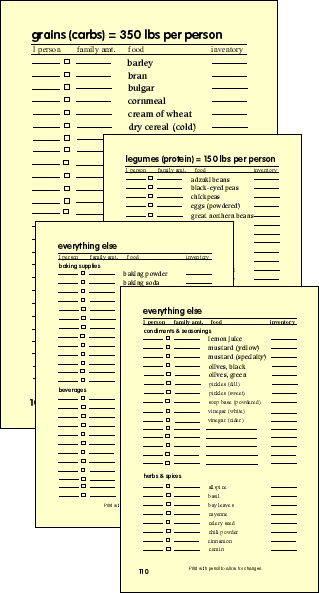Being prepared to survive a crisis means having back-up plans for taking care of the basics: like feeding your family. Storing at least a few weeks to a few months of food is imperative. In the case of winter regions, having enough food to get through the winter, plus spring planting, summer tending and autumn harvest is commonsense.
There’s a lot to consider if you intend to put an effective food storage plan together.
• The Practical Issues Of Food Are Plentiful:
- nutrition
- budget
- shopping/gathering
- storage
- special needs
- preparation
- clean-up
• The Gut Issues Around Food Are Charged With Emotion:
- individual likes and dislikes
- philosophical differences
- cultural preferences
- internal rules (self-imposed food)
It’s difficult enough to balance all the concerns in ordinary times. In times of crisis, having a well thought out plan to rely on is absolutely vital.
To begin, like with everything else in preparedness thinking, you’ll need to assess your particular situation to determine what options suit you best. Living on a farm or even in a rural, agriculturally based, community creates a totally different set of questions than living on the 20th floor in a large city. Your food stocks need to reflect your unique situation. Take your time thinking it through.
If food habits need to be changed, now is the time to do it. Gradual adjustments in diet, meal timing, socializing issues etc. are easier and less painful than rapid no-choice changes. Emergency times are stressful. Attempting such changes in already difficult circumstances will only make the transition harder.
Once you’ve determined both the resources and the challenges that you have to deal with, you can put a viable plan into action.
• Pantry Stores Should Be Based On: (prioritize based on personal options)
- water availability
- storage space
- special needs (food allergies, infants, elderly . . .)
- nutritional value
- minimum packaging
- a combination of: familiar foods; easy to store foods; budget-wise foods
- life expectancy of foods
- storage
In addition to a full chapter on food issues, which includes: food challenges to reckon with, storage considerations, food stock maximizing options and food tips, Do-it-Yourself Crisis Survival has an extensive food inventory checklist.

How Much Food Is Enough?
The average North American consumes 1450 lbs of food each year. To ensure a high nutrition diet, your food intake needs to contain a balanced variety. You may not consider yourself ‘average’, in that case, you can reduce the amount of ‘everything else’, but don’t skimp on healthy foods.
- 350 lbs of grains
- 270 lbs fruit
- 270 lbs vegetables
- 150 lbs legumes (meat alternatives)
- 25 lbs fats & oils
- 25 lbs sugars
- 360 lbs everything else (cakes, cookies, condiments, beverages, potato chips . . .

- 3 cups cooked/canned chick peas
- 1/4 cup lemon juice
- 2-3 cgarlic cloves (crushed)
- 3 TBSP tahini (sesame seed butter)
- sea salt to taste
- olive oil (garnish)
- 2 tsps half and half paprika/cayenne mix (garnish)
- 3/4 cup bean liquid
Mash chick peas to a whipped potato consistency. Add remainder of ingredients; mix well. Mound for service; top with olive oil; sprinkle paprika & cayenne mix. Serve with pita bread. Keeps well in cold storage.
